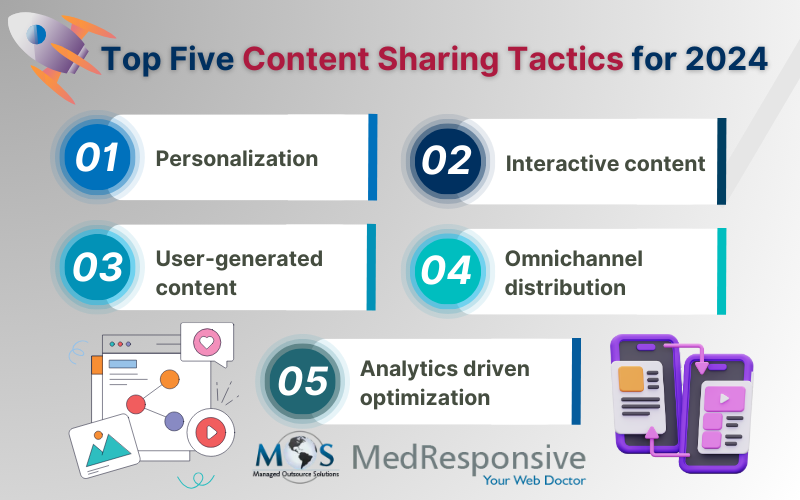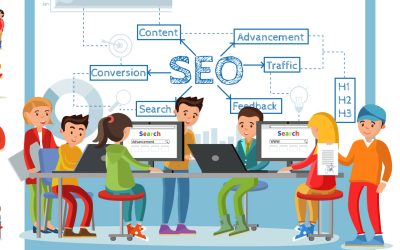Technological advancements such as AI combined with the transformation in traditional content marketing led to the sentiment that the era of content marketing. This notion, however, has turned out be to be false as content marketing continues to generate results, albeit just not in the old way. A 2024 marketing report from HubSpot stated that the demand for content marketing will continue to surge in 2024, with 50% of marketers planning to expand their investment on it. So content marketing isn’t dead, but simply upgraded with shifting consumer behavior and emerging marketing trends. Authentic, beneficial and reliable content is gaining popularity over highly curated traditional content. For this type of content to reach the intended audience, you need to employ modern and inventive content sharing strategy that grasp the attention of targeted audience and influences their decision-making. Hiring third-party content creation services is a practical option to handle your content development as well as sharing for achieving your business goals.
Content Sharing Tactics for 2024
The popular phrase, ‘content is king’ often leads to the misconception that churning out content on a regular basis will magnetically attract an audience. However, that is a thing of the past. The reality is far more complex and what actually works is producing high-quality content that understands the pain points of the audience and provides solutions that is in dialogue with them on an emotional level. But that’s not enough. To optimize its visibility, you need to ensure that your content is strategically distributed across relevant social media platforms. Here are 5 top content sharing tactics for 2024:
Personalization
Personalization is the cornerstone of a successful content sharing strategy and from this point forward, hyper-personalization is becoming the rage. Consumers are bombarded with content 24/7. To cut through the noise and resonate with audience on deeper level, you need to develop and share authentic content that delivers an impactful customer experience. Personalization can take numerous formats such as personalized emails, customized recommendations, and live chat options.
Generic, one-size-fits-all mass messaging is no longer relevant. Harnessing the power of real-time data, AI or machine learning to understand the intricacies of each audience’s behavior can help you deliver content that is relevant to them is in. As technology evolves, so does customer expectations. Use data analysis to tailor your value-driven content that directly speaks to each individual needs and preference. This can foster user trust and credibility, and enhance user engagement and conversion rates. Let’s explore actionable steps to implement personalization in your content sharing strategy:
- Segmentation: The initial critical step for elevating personalization requires you to identify your target audience and segment your audience based on demographic information such as age, gender, interest, behavior and past experience. Ultimately, your aim is to gain deeper understanding of your audience to deliver the right content to right people, based on their preferences.
- Implement personalized recommendations: Track user interactions of your website to offer specialized recommendations or discounts tailored to your customers and earn customer loyalty. Utilize personalized calls-to-action.
- Behavior tracking: Review customer data to understand user behavior for effective content targeting by employing robust customer behavior analyzing tools. By gathering user information, you can tailor content that will result in higher conversion rate and increased sales.
- Measure personalized content: To determine if your content sharing campaign is working effectively, you need to measure KPIs such as conversion rate, bounce rate and time spent on site. You can also experiment with A/B testing to know which versions perform better to mitigate risks and generate greater ROI from all traffic.
- Continuous adaptation: Continue to develop new strategies and engage in proactive user support as the customer service landscape is dynamic and unpredictable to generate exponential content impact for your revenue.
Interactive content
Interactive content has been on the rise for some time, mainly due to audiences no longer wanting to be a passive consumer anymore. Customers want engaging content that encourage active audience participation as they prefer memorable and immersive user experience. Incorporating interactive platforms such as online quizzes, polls, and augmented reality into your content sharing strategy creates interactive user experience that can boost participation rates sky-high and increase dwell time. Not only will this attract your audience, but it will also help build brand awareness in them. As the technology advances, so does the possibilities of creating and improving your interactive content for the users. In the upcoming years, businesses that focus on how to leverage these tools for creating and expanding interactive content that captures your audiences are more likely to achieve better organic traffic and search visibility. Here are the various ways interactive content transform the way brands connect with their audience:
- Enhanced engagement – Possibly the most beneficial aspect of interactive content is the ability to create better user engagement. In today’s competitive landscape, content that stands out not only entertains but also engages. Interactive elements increase the likelihood of attracting user attention and compels them to take action, be it content sharing, providing feedback, or making a purchase.
- Higher conversion rates – Interactive content turns potential audiences into buyers as it can guide prospects through the sales funnel more than static content does. Beyond cultivating improved brand awareness and user engagement, interactive content can create diverse monetization opportunities and even generate twice as many conversions compared to passive content.
- Personalization and improved data collection – Unlike traditional content, interactive content offers personalization which provides better user interactions. Reviewing this user data allows businesses to gather knowledge and insights into user preferences, behavior, and interests.
- Lead generation – Interactive content serves as a powerful tool for lead generation as they can be combined with serviceable landing page and eye-catching calls-to-action. These tools help in strong lead capture efforts by weeding out weak audiences and nurturing high-potential leads.
- Improved user experience – When users receive what they want through interactive content, it provides a richer user experience. By customizing content learned through user data collection, you can deliver content that matches their preferences, needs or interests.
User generated content
One marketing element that has been steadily on the rise is user-generated content. Leveraging it is an effective way to build customer trust and amplify brand image. Customers don’t want to limit themselves to only consuming content, but also want to be part of the story that is shared by the brands they love. Businesses can brainstorm exciting innovative ideas that leverage user-generated content (UGC) in various ways such as sharing user reviews, photos or videos and executing campaigns that actively involves them to get followers. Integrating real human stories, opinions and experience in marketing is becoming increasingly popular as consumers are attracted to authentic, reliable content. Let’s dive into few advantages that user-generated content offers for your business:
- Authenticity – User-generated content transmits an undeniable layer of authenticity to your content that often other traditional means of marketing cannot provide. Customers crave honest, trustworthy content and when this content is generated through them, it constructs an air of unfiltered, honest and genuine content that resonates deeply with them.
- Cost-effective – As the source of user-generated content is the audience themselves, this type of content creation is a budget-friendly option especially for small businesses looking to grow their audience. Enthusiastic content creators can help deliver campaigns for your brand by utilizing social media through various ways such as branded hashtags, uncovering content that lies in brand tag and launching giveaways. With permission, you can repurpose this content in your marketing campaigns.
- Community building – UGC fosters a sense of community building and bonding around shared audience interest. When your customers have a platform to voice their opinion, they feel valued and heard which in-turn encourages others to participate in discussions. This can promote deeper connections with your audience, driving increased web traffic, brand exposure, and conversion.
- Offers convenience – Omnichannel distribution not only benefits your audience but also generates more revenue. When customers engage with your brand through their preferred channel, you increase accessibility and overall user experience, encouraging current customer retention and attracting new customers as well.
- Builds customer loyalty – When your services are available at their fingertips, customers enjoy the flexibility through which your product or service can be purchased. This increases customer satisfaction as well as retention and help boost your sales.
- Improves inventory management – When your service or product is consistently sold through various channels, the risk of the inventory staying stagnant decreases. Based on customer demand, you can understand which product needs increased inventory and which doesn’t.
- Informed strategy: You can utilize content analytics for measuring traffic, bounce rates engagement and conversion rates. Gaining insight into what type of content resonates with your audience helps you make informed decision about your content marketing strategy.
- Cost metrics: The primary objective of any content marketing strategy is to improve ROI. Cost-driven metrics help you understand the type of content and marketing strategy that maximizes ROI. This allows your company to allocate resources appropriately for achieving amplified impact.
- Accuracy: Since you have to deal with vast amount of data for content analysis, automation can help process this data accurately, eliminating human error and ensuring optimized results.
- Real-time adaptation: To achieve the desired goals set for your content marketing, it is important to be adaptable as it is not a onetime event. Regular and continuous analysis can spot trends and uncover patterns and shifts in user behavior to extract and learn new information as it comes in.
Omnichannel distribution
Audiences engage with multiple platforms and devices daily. This means that your content sharing strategy should encompass cross-platform content distribution system to reach diverse audience across all channels. Brands should focus on circulating content through numerous platforms such as social media, emails, blogs and podcasts. To accomplish this, it is necessary to comprehend the distinctive features and nuances of each platform. According to the HubSpot report, short-form video has emerged as the top leveraged media format in content marketing strategies. When you adopt an omnichannel distribution system, it is important to select the channels based on audience presence as well as business goals that aligns with your strategy. Here are few benefits of omnichannel distribution:
Analytics-driven optimization
Finally, to make sure that you deliver right content at the right direction, you need to a data-driven guidance system. Digital marketing analytics metrics offer you proper insight into your audience’s behavior, content visibility and conversion path. Developing data-driven content strategy helps you set relevant business goals, collect data and measure performance to continuously update your strategy. This analytics driven system is needed for making informed decisions that influence the impact of your content marketing to improve engagement and conversion rates. Here are few benefits of employing analytics in your marketing strategy:
Implementing the above-listed content sharing tactics will enable you to create an effective content marketing strategy based on your resources and budget. As you or your staff may not possess the technical knowledge and experience required to improve content marketing, you can delegate this task to an SEO outsourcing company. Experts can help you boost revenue and achieve your business goals with optimized content marketing strategies.





